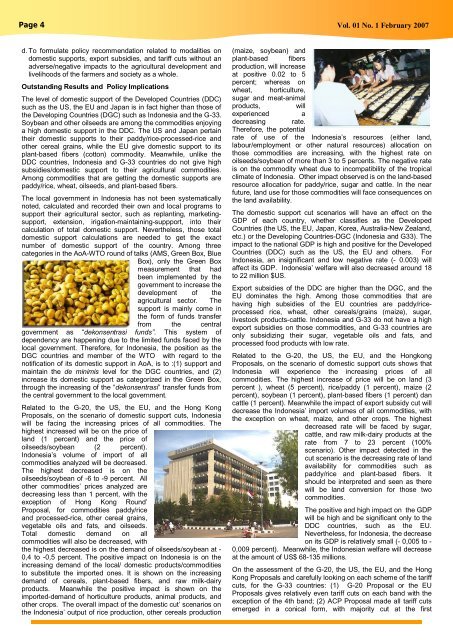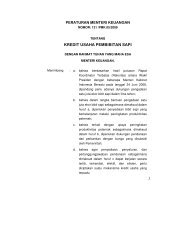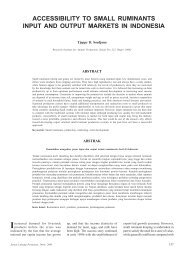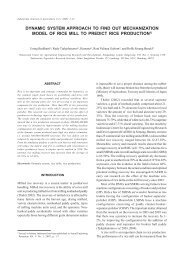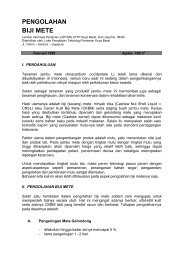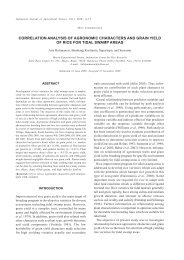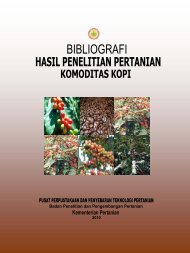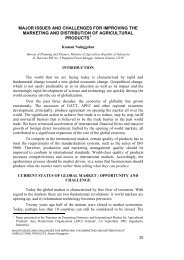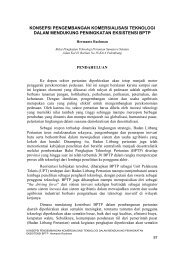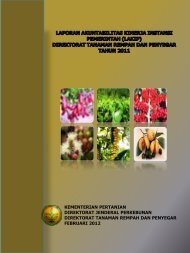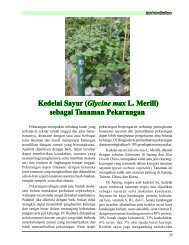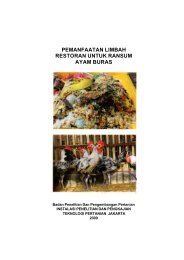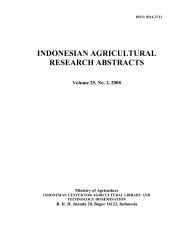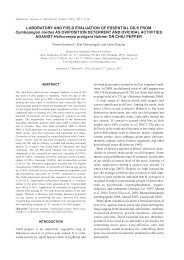Agro-SocioeconomicNewsletter - Pusat Sosial Ekonomi dan ...
Agro-SocioeconomicNewsletter - Pusat Sosial Ekonomi dan ...
Agro-SocioeconomicNewsletter - Pusat Sosial Ekonomi dan ...
- No tags were found...
Create successful ePaper yourself
Turn your PDF publications into a flip-book with our unique Google optimized e-Paper software.
Page 4Vol. 01 No. 1 February 2007d. To formulate policy recommendation related to modalities ondomestic supports, export subsidies, and tariff cuts without anadverse/negative impacts to the agricultural development andlivelihoods of the farmers and society as a whole.Outstanding Results and Policy ImplicationsThe level of domestic support of the Developed Countries (DDC)such as the US, the EU and Japan is in fact higher than those ofthe Developing Countries (DGC) such as Indonesia and the G-33.Soybean and other oilseeds are among the commodities enjoyinga high domestic support in the DDC. The US and Japan pertaintheir domestic supports to their paddy/rice-processed-rice andother cereal grains, while the EU give domestic support to itsplant-based fibers (cotton) commodity. Meanwhile, unlike theDDC countries, Indonesia and G-33 countries do not give highsubsidies/domestic support to their agricultural commodities.Among commodities that are getting the domestic supports arepaddy/rice, wheat, oilseeds, and plant-based fibers.The local government in Indonesia has not been systematicallynoted, calculated and recorded their own and local programs tosupport their agricultural sector, such as replanting, marketingsupport,extension, irigation-maintaining-suppport, into theircalculation of total domestic support. Nevertheless, those totaldomestic support calculations are needed to get the exactnumber of domestic support of the country. Among threecategories in the AoA-WTO round of talks (AMS, Green Box, BlueBox), only the Green Boxmeasurement that hadbeen implemented by thegovernment to increase thedevelopment of theagricultural sector. Thesupport is mainly come inthe form of funds transferfrom the centralgovernment as “dekonsentrasi funds”. This system ofdependency are happening due to the limited funds faced by thelocal government. Therefore, for Indonesia, the position as theDGC countries and member of the WTO with regard to thenotification of its domestic support in AoA, is to :(1) support andmaintain the de minimis level for the DGC countries, and (2)increase its domestic support as categorized in the Green Box,through the increasing of the “dekonsentrasi” transfer funds fromthe central government to the local government.Related to the G-20, the US, the EU, and the Hong KongProposals, on the scenario of domestic support cuts, Indonesiawill be facing the increasing prices of all commodities. Thehighest increased will be on the price ofland (1 percent) and the price ofoilseeds/soybean (2 percent).Indonesia’s volume of import of allcommodities analyzed will be decreased.The highest decreased is on theoilseeds/soybean of -6 to -9 percent. Allother commodities’ prices analyzed aredecreasing less than 1 percent, with theexception of Hong Kong Round’Proposal, for commodities paddy/riceand processed-rice, other cereal grains,vegetable oils and fats, and oilseeds.Total domestic demand on allcommodities will also be decreased, withthe highest decreased is on the demand of oilseeds/soybean at -0,4 to -0,5 percent. The positive impact on Indonesia is on theincreasing demand of the local/ domestic products/commoditiesto substitute the imported ones. It is shown on the increasingdemand of cereals, plant-based fibers, and raw milk-dairyproducts. Meanwhile the positive impact is shown on theimported-demand of horticulture products, animal products, andother crops. The overall impact of the domestic cut’ scenarios onthe Indonesia’ output of rice production, other cereals production(maize, soybean) andplant-based fibersproduction, will increaseat positive 0.02 to 5percent; whereas onwheat, horticulture,sugar and meat-animalproducts,willexperienced adecreasing rate.Therefore, the potentialrate of use of the Indonesia’s resources (either land,labour/employment or other natural resources) allocation onthose commodities are increasing, with the highest rate onoilseeds/soybean of more than 3 to 5 percents. The negative rateis on the commodity wheat due to incompatibility of the tropicalclimate of Indonesia. Other impact observed is on the land-basedresource allocation for paddy/rice, sugar and cattle. In the nearfuture, land use for those commodities will face consequences onthe land availability.The domestic support cut scenarios will have an effect on theGDP of each country, whether classifies as the DevelopedCountries (the US, the EU, Japan, Korea, Australia-New Zealand,etc.) or the Developing Countries-DGC (Indonesia and G33). Theimpact to the national GDP is high and positive for the DevelopedCountries (DDC) such as the US, the EU and others. ForIndonesia, an insignificant and low negative rate (- 0.003) willaffect its GDP. Indonesia’ welfare will also decreased around 18to 22 million $US.Export subsidies of the DDC are higher than the DGC, and theEU dominates the high. Among those commodities that arehaving high subsidies of the EU countries are paddy/riceprocessedrice, wheat, other cereals/grains (maize), sugar,livestock products-cattle. Indonesia and G-33 do not have a highexport subsidies on those commodities, and G-33 countries areonly subsidizing their sugar, vegetable oils and fats, andprocessed food products with low rate.Related to the G-20, the US, the EU, and the HongkongProposals, on the scenario of domestic support cuts shows thatIndonesia will experience the increasing prices of allcommodities. The highest increase of price will be on land (3percent ), wheat (5 percent), rice/paddy (1 percent), maize (2percent), soybean (1 percent), plant-based fibers (1 percent) <strong>dan</strong>cattle (1 percent). Meanwhile the impact of export subsidy cut willdecrease the Indonesia’ import volumes of all commodities, withthe exception on wheat, maize, and other crops. The highestdecreased rate will be faced by sugar,cattle, and raw milk-dairy products at therate from 7 to 23 percent (100%scenario). Other impact detected in thecut scenario is the decreasing rate of landavailability for commodities such aspaddy/rice and plant-based fibers. Itshould be interpreted and seen as therewill be land conversion for those twocommodities.The positive and high impact on the GDPwill be high and be significant only to theDDC countries, such as the EU.Nevertheless, for Indonesia, the decreaseon its GDP is relatively small (- 0,005 to -0,009 percent). Meanwhile, the Indonesian welfare will decreaseat the amount of US$ 68-135 millions.On the assessment of the G-20, the US, the EU, and the HongKong Proposals and carefully looking on each scheme of the tariffcuts, for the G-33 countries: (1) G-20 Proposal or the EUProposals gives relatively even tariff cuts on each band with theexception of the 4th band; (2) ACP Proposal made all tariff cutsemerged in a conical form, with majority cut at the first


